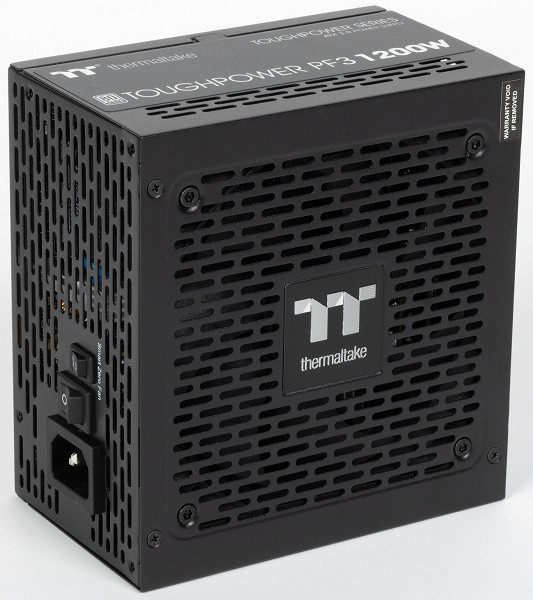
Particularly high-power power supplies (from 1000 W) are usually purchased for specific tasks — specialized test systems, high-load computers for rendering, calculations, and also for overclocking. Sometimes such power supplies are purchased to create a significant power reserve for an existing system or with an eye toward a future upgrade. The cost of such solutions can vary significantly, which confronts the buyer with the difficult task of choosing a model with the optimal price-quality ratio. Today we will look at one of the available solutions on the market.
This time we got Thermaltake's top product for testing: Toughpower PF3 1200W. This is a power supply with 80Plus Platinum certification, which makes it an expensive model even in the power supply segment with a power of more than a kilowatt. At the time of publication of the review, its retail price started at $230.

The Thermaltake Toughpower PF3 1200W cooling system supports two operating modes: hybrid, in which the fan does not rotate under certain conditions, and normal, with the fan constantly running. Switching between modes is carried out using a two-position key on the external panel of the power supply case (the On position corresponds to the hybrid mode).
The power supply housing is approximately 140 mm long. An additional 15-20 mm will be needed to connect the wires, so when installing, you should take into account the total size of about 160 mm. For power supplies of this power, these dimensions can be considered as compact as possible.
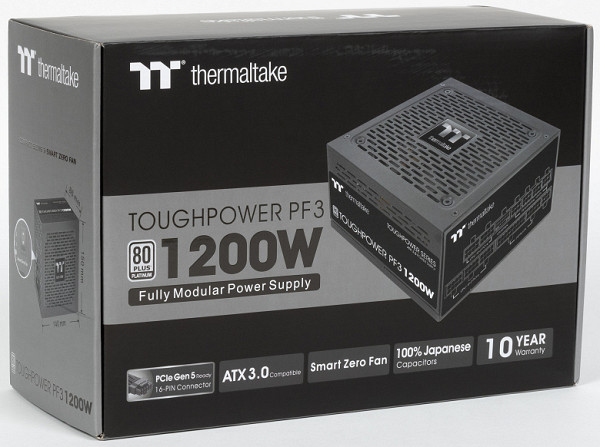
The packaging is made of durable cardboard with matte printing and an image of the power supply itself. The design is dominated by black and gray shades.
Characteristics
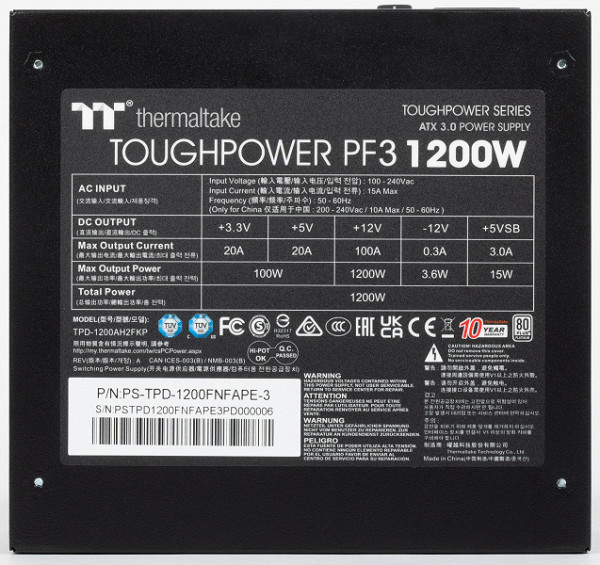
All important parameters are indicated on the power supply housing. The power of the +12VDC bus is 1200 W, which is equal to 100% of the total power, which is an excellent indicator.
Wires and connectors
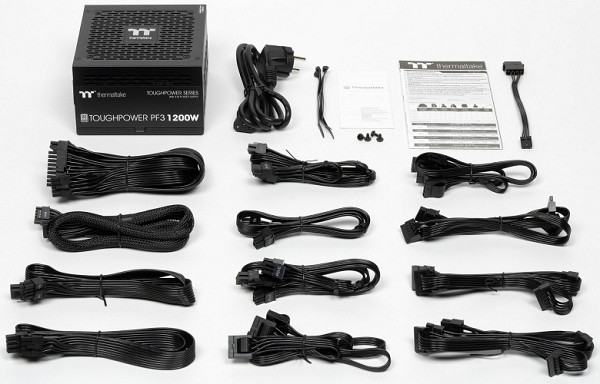
| Name of the connector | Number of connectors | Notes |
|---|---|---|
| 24 pin Main Power Connector | 1 | collapsible |
| 4 pin 12V Power Connector | — | |
| 8 pin SSI Processor Connector | 2 | collapsible |
| 6 pin PCIe 1.0 VGA Power Connector | — | |
| 8 pin PCIe 2.0 VGA Power Connector | 5 | on 3 cords |
| 16 pin PCIe 5.0 VGA Power Connector | 1 | |
| 4 pin Peripheral Connector | 8 | ergonomic |
| 15 pin Serial ATA Connector | 12 | on 3 cords |
| 4 pin floppy drive connector | 1 | adapter from peripheral connector |
Length of wires to power connectors
Without exception, all wires are modular, that is, they can be removed, leaving only those that are necessary for a particular system.

- The cord to the main ATX connector is 60 cm.
- Two cords to the 8 pin SSI processor socket — 67 cm.
- Cable to the video card power connector PCIe 2.0 VGA Power Connector — 52 cm.
- Two cords to the first power connector of the PCIe 2.0 VGA Power Connector video card — 50 cm, plus another 15 cm to the second similar connector.
- Cable to the video card power connector PCIe 5.0 VGA Power Connector (12VHPWR) — 60 cm.
- Three cords to the first SATA Power Connector — 50 cm, plus 15 cm to the second, another 15 cm to the third and another 15 cm to the fourth same connector.
- Two cords to the first Peripheral Connector (Molex) — 50 cm, plus 15 cm to the second, another 15 cm to the third and another 15 cm to the fourth similar connector.
- Power adapter from the Peripheral Connector (Molex) to the FDD power connector — 15 cm.
The length of the wires ensures comfortable use in full tower and larger cases with a top-mounted power supply. In cases up to 55 cm high with a bottom-mounted power supply, the length of the wires should also be sufficient: 67 cm to the processor power connectors. Thus, there should be no problems with most modern cases.
Some modern power supplies come with a convenient adapter cord from a PCIe 5.0 connector to two PCIe 2.0 connectors. In this case, there is no such cord included.
All SATA Power connectors, with the exception of the outermost ones on each cord, are angled, which is inconvenient for drives placed on the back of the motherboard base. I would also like to see cords with 1-2 power connectors with a straight plug for connecting devices in places with difficult access.
The use of ribbon wires is positively noted. Only up to the 12VHPWR connector is a standard nylon braided cord used, which is less convenient to use, since it collects dust well, but is difficult to clean from it.
Circuit design and cooling
The power supply is equipped with an active power factor correction and supports a wide range of supply voltages from 100 to 240 volts, which ensures resistance to low voltage in the mains.
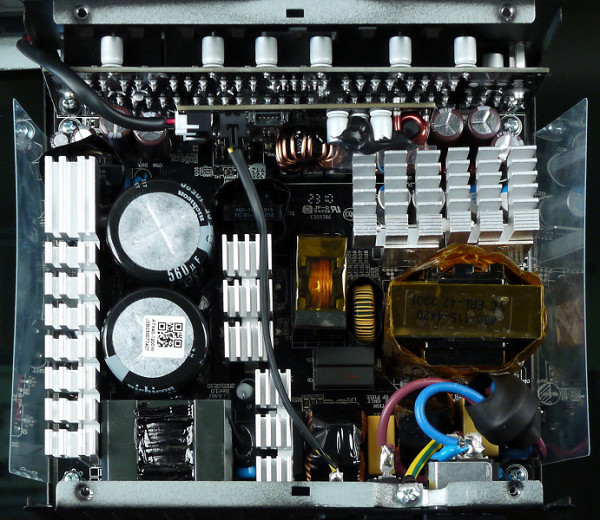
The design of the power supply meets modern standards: it is equipped with an active power factor corrector, a synchronous rectifier for the +12VDC channel and independent pulsed DC converters for the +3.3VDC and +5VDC lines.
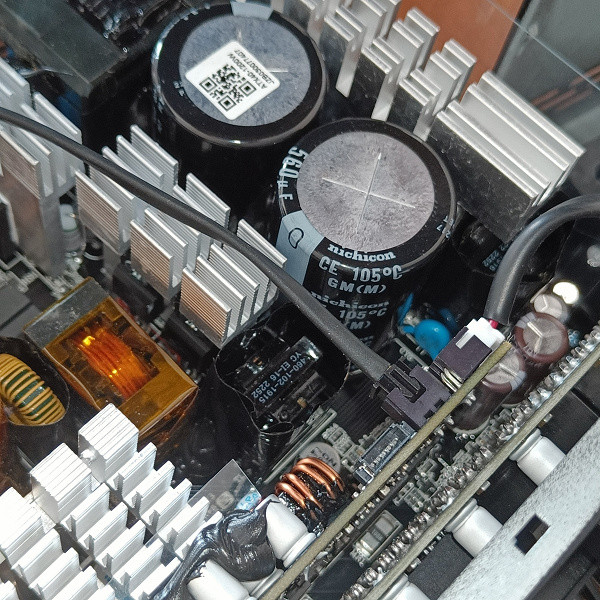
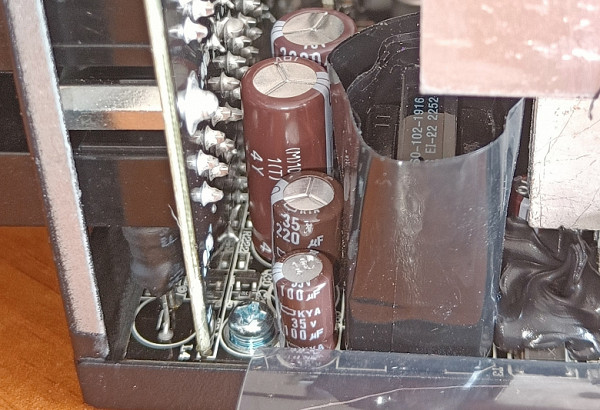
Semiconductor elements of high-voltage circuits are located on two radiators, and the input rectifier is installed on a separate heat sink. The elements of the synchronous rectifier are located on the front side of the main printed circuit board under a massive radiator.
Independent sources of +3.3VDC and +5VDC are installed on the daughter printed circuit board and do not have additional heat sinks, which is typical for power supplies with active cooling.
The power supply uses Nichicon high-voltage capacitors and Nippon Chemi-Con branded low-voltage capacitors. A large number of polymer capacitors are also installed.

The power supply has a fan on a hydrodynamic bearing, which guarantees a very long service life. The fan is branded as Thermaltake, its original model is BDK 12025MS, manufactured by Shenzhen Baodikai Tech. The fan connection is made two-wire, via a connector.
Electrical Characteristics Measurement
Next, we move on to an instrumental study of the electrical characteristics of the power supply using a multifunctional stand and other equipment.
The deviation of the output voltages from the nominal value is color coded as follows:
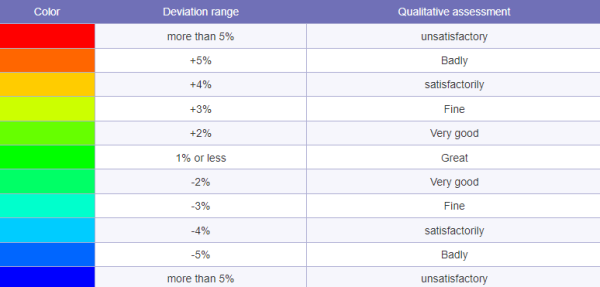
Operating at maximum power
During the first stage of testing, the power supply operates at maximum power for an extended period of time. This test allows you to confidently check its performance.
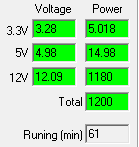
Cross-load characteristic
At the next stage of testing, a cross-load characteristic (CLC) is constructed, displayed on a graph, where the maximum power for 3.3 V and 5 V buses is indicated on the ordinate axis, and for the 12 V bus on the abscissa axis. At each point of the graph, the measured voltage is indicated in color marker depending on the deviation from the nominal value.
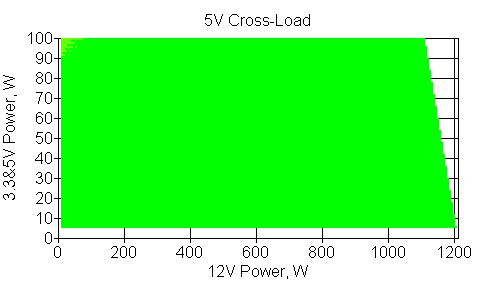
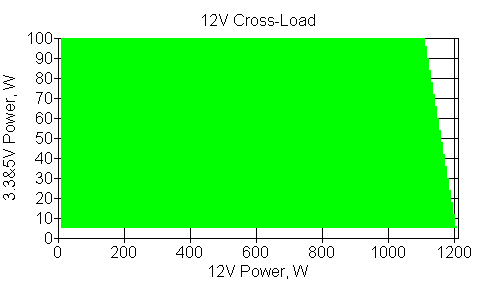

The cross-load characteristic (CLC) allows you to determine the permissible load level, especially for the +12VDC channel, of the power supply being tested. In this case, voltage deviations along the +12VDC channel do not exceed 1% over the entire power range, which is an excellent result. With a typical load distribution, deviations do not exceed 1% across all three channels — +3.3VDC, +5VDC and +12VDC. This power supply model is perfect for powerful modern systems due to the high load capacity of the +12VDC channel.
Load capacity
The following test is designed to determine the maximum power that can be supplied through the power supply connectors when the voltage tolerance is within 3 or 5 percent of the nominal voltage.

In the case of a video card with a single power connector, the maximum power over the +12VDC channel is at least 150 W with a deviation within 3%.

In the case of a video card with two power connectors when using one power cord, the maximum power over the +12VDC channel is at least 250 W with a deviation within 3%.

For a video card with two power connectors, the maximum power via the +12VDC channel reaches at least 350 W with a voltage deviation within 3%. This allows the use of very powerful video cards.

When loaded through four PCIe 2.0 connectors, the maximum power over the +12VDC channel is at least 650 W with a deviation within 3%.

When connecting the processor power connector, the maximum power via the +12VDC channel is at least 250 W with a deviation within 3%. This is sufficient for most systems with a single CPU power connector on the motherboard.

When loaded through two processor power connectors, the maximum power via the +12VDC channel is about 500 W with a deviation within 3%.

For a motherboard, the maximum power on the +12VDC channel is at least 150 W with a deviation of 3%. Since the board itself consumes about 10 W on this channel, the remaining power reserve can be used to power expansion cards, such as graphics cards without additional power, which typically consume up to 75 W. However, given the power of the power supply, such a scenario is unlikely.
Cost-effective and efficient
Assessing the efficiency of a computer power supply can be done in two main ways. The first method involves analyzing the power supply as a separate energy converter, where the focus is on minimizing the resistance of the power transmission line from the power supply to the load. In this case, the power supply is connected using all available connectors, which creates unequal conditions for different models, since the number and type of connectors may vary, even for power supplies of the same power. While these results are valid for each individual power supply, they are less applicable in real-world environments where the power supply has a limited number of connectors.
Another approach is to estimate the efficiency of the power supply based on fixed power values and a specific set of connectors. This allows you to more objectively compare the efficiency of different models under the same conditions, taking into account the power distribution across channels and real operating conditions.
The coefficient of performance (efficiency) of a power supply is a traditional parameter showing the ratio of the output and input powers of the power supply. Although high efficiency may indicate better quality and cost-effectiveness, it does not have a noticeable impact on the performance, noise or temperature of the system unit. KPI is often used in marketing, especially in combination with certifications such as 80Plus, but for the practical user its value is limited.
To objectively evaluate the efficiency of a power supply, it is more useful to consider absolute values, such as power dissipation (the difference between input and output power) and energy consumption over time. This allows you to calculate the true difference in power consumption and calculate the potential economic benefits of using more efficient power supplies.
For example, power dissipation can be converted into kilowatt-hours (kWh), which are recorded by an electrical energy meter. By multiplying this value by the cost of a kilowatt-hour, you can calculate the cost of electricity for a year with round-the-clock operation of the system unit. This method helps you evaluate the long-term efficiency of different power supplies and make a more informed choice.
In our research, we identified several typical power options and correlated them with the number of connectors corresponding to these options. This allows you to more accurately compare the efficiency of different power supply models under real operating conditions.
| Load via connectors | 12VDC, W | 5VDC, W | 3.3VDC, W | Total power, W |
|---|---|---|---|---|
| Main ATX, CPU (12V), SATA | 5 | 5 | 5 | 15 |
| Main ATX, CPU (12V), SATA | 80 | 15 | 5 | 100 |
| Main ATX, CPU (12V), SATA | 180 | 15 | 5 | 200 |
| Main ATX, CPU (12V), 6-pin PCIe, SATA | 380 | 15 | 5 | 400 |
| Main ATX, CPU (12V), 6-pin PCIe (1 cable with 2 connectors), SATA | 480 | 15 | 5 | 500 |
| Main ATX, CPU (12V), 6-pin PCIe (2 cables with 1 connector), SATA | 480 | 15 | 5 | 500 |
| Main ATX, CPU (12V), 6-pin PCIe (2 cables with 2 connectors), SATA | 730 | 15 | 5 | 750 |
The results obtained are as follows:
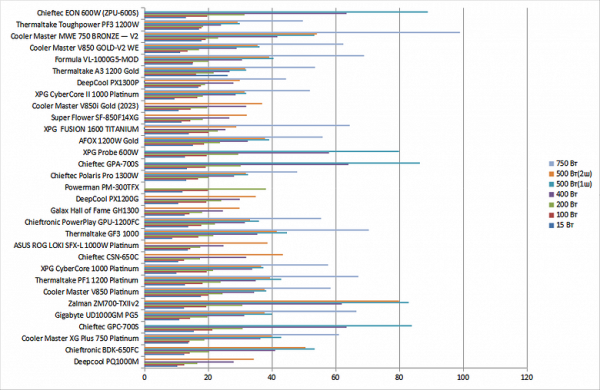
| Dissipated power, W | 15 W | 100 W | 200 W | 400 W | 500 W (1 cord) | 500W (2 cords) | 750 W |
|---|---|---|---|---|---|---|---|
| Cooler Master V1000 Platinum (2020) | 19.8 | 21.0 | 25.5 | 38.0 | 43.5 | 41.0 | 55.3 |
| Thermaltake TF1 1550 | 13.8 | 15.1 | 17.0 | 24.2 | 30.0 | 42.0 | |
| Thermaltake GF1 1000 | 15.2 | 18.1 | 21.5 | 31.5 | 38.0 | 37.3 | 65.0 |
| Chieftec PPS-1050FC | 10.8 | 13.0 | 17.4 | 29.1 | 35.1 | 34.6 | 58.0 |
| Deepcool PQ1000M | 10.4 | 12.6 | 16.7 | 28.1 | 34.4 | ||
| Gigabyte UD1000GM PG5 | 11.0 | 14.4 | 19.9 | 31.4 | 40.1 | 37.8 | 66.6 |
| Thermaltake PF1 1200 Platinum | 12.8 | 18.3 | 24.0 | 35.0 | 43.0 | 39.5 | 67.2 |
| XPG CyberCore 1000 Platinum | 10.1 | 19.6 | 21.6 | 33.9 | 37.4 | 36.7 | 57.7 |
| Asus ROG Loki SFX-L 1000W Platinum | 13.7 | 14.5 | 17.6 | 24.9 | 38.7 | ||
| Thermaltake GF3 1000 | 8.8 | 17.0 | 21.7 | 35.5 | 44.8 | 41.6 | 70.5 |
| Chieftronic PowerPlay GPU-1200FC | 13.8 | 17.9 | 22.2 | 31.6 | 36.0 | 33.2 | 55.5 |
| Galax Hall of Fame GH1300 | 12.7 | 14.2 | 18.2 | 24.7 | 29.9 | ||
| Deepcool PX1200G | 10.7 | 19.5 | 24.2 | 30.0 | 35.0 | ||
| Chieftec Polaris Pro 1300W | 13.2 | 16.9 | 20.3 | 28.2 | 32.6 | 31.9 | 48.0 |
| Afox 1200W Gold | 15.3 | 18.8 | 23.8 | 32.5 | 39.2 | 37.9 | 56.0 |
| XPG Fusion 1600 Titanium | 14.0 | 20.2 | 23.1 | 25.5 | 28.9 | 64.5 | |
| XPG CyberCore II 1000 Platinum | 9.5 | 16.7 | 18.4 | 28.7 | 32.0 | 31.5 | 52.0 |
| DeepCool PX1300P | 17.0 | 17.8 | 19.1 | 28.0 | 30.0 | 44.5 | |
| Thermaltake GF A3 Gold 1200W | 26.2 | 16.3 | 21.8 | 26.8 | 32.0 | 31.7 | 53.6 |
| Formula VL-1000G5-MOD | 15.2 | 15.3 | 20.1 | 30.7 | 40.6 | 39.2 | 69.0 |
| Thermaltake Toughpower PF3 1200W | 17.2 | 18.0 | 18.5 | 24.1 | 30.0 | 29.3 | 49.8 |
This model has high efficiency with a load power of 750 W, and in general demonstrates quite typical efficiency for devices with 80Plus Platinum certification.

In terms of overall efficiency at low and medium power, this model ranks high on our list of power supplies with power from kilowatt at the time of testing.
| Energy consumption of a computer per year, kW h | 15 W | 100 W | 200 W | 400 W | 500 W (1 cord) | 500W (2 cords) | 750 W |
|---|---|---|---|---|---|---|---|
| Cooler Master V1000 Platinum (2020) | 305 | 1060 | 1975 | 3837 | 4761 | 4739 | 7054 |
| Thermaltake TF1 1550 | 252 | 1008 | 1901 | 3716 | 4643 | 6938 | |
| Thermaltake GF1 1000 | 265 | 1035 | 1940 | 3780 | 4713 | 4707 | 7139 |
| Chieftec PPS-1050FC | 226 | 990 | 1904 | 3759 | 4688 | 4683 | 7078 |
| Deepcool PQ1000M | 223 | 986 | 1898 | 3750 | 4681 | ||
| Gigabyte UD1000GM PG5 | 228 | 1002 | 1926 | 3779 | 4731 | 4711 | 7153 |
| Thermaltake PF1 1200 Platinum | 244 | 1036 | 1962 | 3811 | 4757 | 4726 | 7159 |
| XPG CyberCore 1000 Platinum | 220 | 1048 | 1941 | 3801 | 4708 | 4702 | 7076 |
| Asus ROG Loki SFX-L 1000W Platinum | 251 | 1003 | 1906 | 3722 | 4719 | ||
| Thermaltake GF3 1000 | 209 | 1025 | 1942 | 3815 | 4772 | 4744 | 7188 |
| Chieftronic PowerPlay GPU-1200FC | 252 | 1033 | 1947 | 3781 | 4695 | 4671 | 7056 |
| Galax Hall of Fame GH1300 | 243 | 1000 | 1911 | 3720 | 4642 | ||
| Deepcool PX1200G | 225 | 1047 | 1964 | 3767 | 4687 | ||
| Chieftec Polaris Pro 1300W | 247 | 1024 | 1930 | 3751 | 4666 | 4659 | 6991 |
| Afox 1200W Gold | 265 | 1041 | 1961 | 3789 | 4723 | 4712 | 7061 |
| XPG Fusion 1600 Titanium | 254 | 1053 | 1954 | 3727 | 4633 | 7135 | |
| XPG CyberCore II 1000 Platinum | 215 | 1022 | 1913 | 3755 | 4660 | 4656 | 7026 |
| DeepCool PX1300P | 280 | 1032 | 1919 | 3749 | 4643 | 6960 | |
| Thermaltake GF A3 Gold 1200W | 361 | 1019 | 1943 | 3739 | 4660 | 4658 | 7040 |
| Formula VL-1000G5-MOD | 265 | 1010 | 1928 | 3773 | 4736 | 4723 | 7174 |
| Thermaltake Toughpower PF3 1200W | 282 | 1034 | 1914 | 3715 | 4643 | 4637 | 7006 |
In this case, we also present measurements of traditional efficiency . The results were recorded with a constant load on the +3.3VDC (5 W) and +5VDC (15 W) channels and variable power on the +12VDC channel.
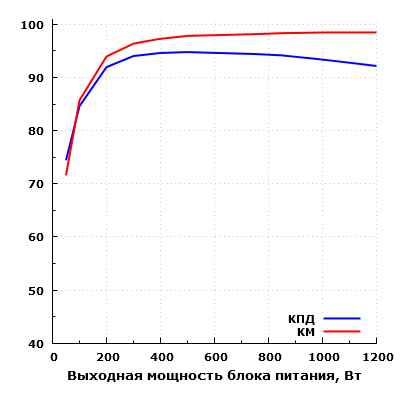
During the tests, we measured the parameters of the power supply at 10 different points. As a result, the maximum efficiency was 94.8% with an output power of 500 W. The maximum power dissipation reached 102 W with an output power of 1000 W, which is a very low figure for a power supply of such power.
Temperature
All main tests were carried out in mode with a constantly rotating fan. The thermal load of the capacitors at loads up to 1000 W remained low (up to 65 degrees), with the exception of operation at maximum power. At a load of 1200 W, the thermal load was significantly higher, but still within satisfactory values.
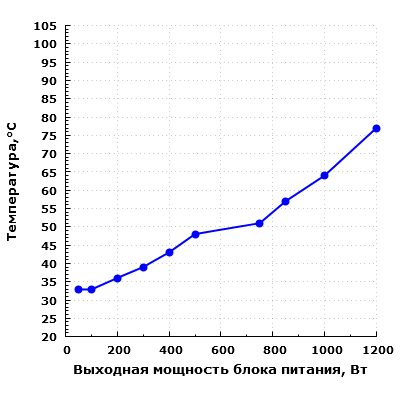
We also tested the power supply in hybrid mode, where the fan turns on only when a certain power is reached.
The results showed that under normal conditions the fan turns on when a threshold power of 450 W is reached. Although there is supposed to be a temperature threshold for turning on the fan, we were not able to achieve it. The fan turns off when the output power drops below 450W.
When operating in fan-stop mode, the temperature inside the power supply reaches 72 degrees at a load of 420 W, which is high enough for constant operation. Although the temperature is higher at 1200 W, prolonged use at 1200 W and 420 W is significantly different, and the increased heat can shorten the life of components, especially capacitors. Therefore, it would be advisable to lower the fan threshold to a more reasonable level.
In addition, the temperature inside the power supply in fanless mode is highly dependent on the ambient temperature. When the air temperature rises to 40-45°C, the fan will turn on earlier.
Acoustic ergonomics
In preparing this material, we used the following method for measuring the noise level of power supplies. The power supply is placed on a flat surface with the fan facing up, and the measuring microphone of the Oktava 110A-Eco sound level meter is installed at a distance of 0.35 meters from the unit. The load on the power supply is created using a special stand operating in silent mode. Noise level measurements are carried out after 20 minutes of operating the power supply at constant power.
This distance to the measurement object is as close as possible to the conditions for desktop placement of the system unit. This method allows you to evaluate the noise level of a power supply in harsh environments where the distance between the noise source and the user is minimal. As the distance to the noise source increases and the presence of sound-reflecting barriers, the noise level at the control point will decrease, which will improve acoustic ergonomics.
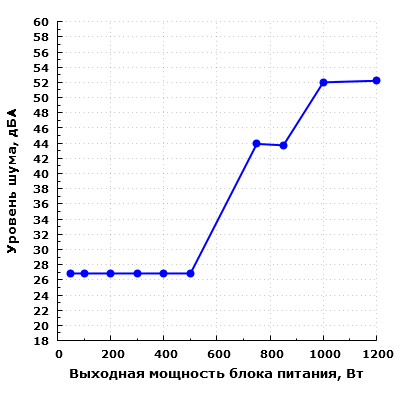
When operating with a constantly rotating fan and a load of up to 500 W inclusive, the noise level of the power supply is about 27 dBA at a distance of 0.35 meters, which is low for a residential area during the daytime.
At a load of about 600 W, the noise level increases sharply, and at 750 W it exceeds 40 dBA, which is already considered high for a residential area. When increasing power to 850 W, the noise level remains virtually unchanged.
When operating at a power of 1000 W, the noise level becomes very high, exceeding 50 dBA, which is uncomfortable even for an office space. At maximum power, the noise level reaches about 52 dBA and hardly increases.
From the point of view of acoustic ergonomics, this model provides a comfortable noise level at power up to 500 W, but when operating at power close to maximum, the noise becomes high.
The operation of the power supply electronics was also assessed for the presence of unwanted sounds. The measurements were made by determining the difference between the noise level in the laboratory with the power supply on and off. A difference of up to 5 dBA indicates no abnormality, while a difference of more than 10 dBA may indicate defects that can be heard from a distance of less than half a meter. The measurements were carried out in two modes: in standby mode (STB, or Stand by) and when the power supply was operating with the fan stopped. The sound level meter microphone was located at a distance of about 40 mm from the top plane of the power supply.
| Power | Noise level from the grille side | Deviation from background level |
|---|---|---|
| 50 W | 23.7 dBA | +3.7 dBA |
| 100 W | 22.6 dBA | +2.6 dBA |
| 200 W | 22.1 dBA | +2.1 dBA |
| 300 W | 22.2 dBA | +2.2 dBA |
| 400 W | 22.2 dBA | +2.2 dBA |
There are no special complaints about the noise of the electronics, it is really low, and it is impossible to hear it from a typical distance.
Consumer qualities
The consumer qualities of Thermaltake Toughpower PF3 1200W are impressive: its high load capacity on the +12VDC channel allows it to be used in powerful systems with multiple video cards. Although the acoustic ergonomics at maximum power leave much to be desired, this is typical for power supplies with this power level, since as the load increases, the amount of power dissipated also increases. In real world conditions, when components draw around 1000 watts, they will generate significant noise on their own. However, at loads up to 500 W, the noise remains low.
Hybrid mode, which can turn off the fan below 450W, works for a long time, but its implementation could be better, since prolonged heating of the power supply components can negatively affect the life of the capacitors.
The wires are long enough for most modern cases, and they are predominantly ribbon, which simplifies assembly and operation.
Results
Thermaltake Toughpower PF3 1200W demonstrates high efficiency and reliability thanks to a fan with a fluid dynamic bearing and capacitors made in Japan. This power supply supports hybrid cooling mode and can run for long periods of time with the fan stopped at up to 450W of power. However, in hybrid mode, the temperature inside the unit can reach 70 degrees, which is not ideal for capacitors, including polymer ones. This limitation is specific to the hybrid mode; in the mode with a constantly rotating fan, the thermal load is significantly lower, even at almost maximum load.
In general, this power supply is suitable for use in powerful systems, especially in traditional mode with a running fan. It is best suited for work systems where absolutely minimal noise levels are required.
